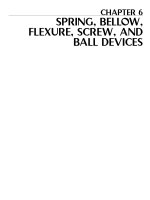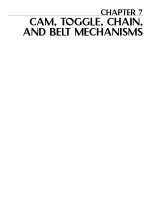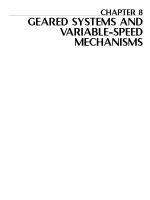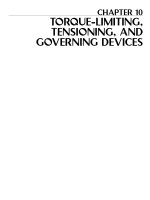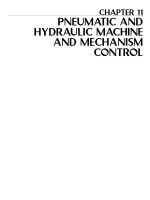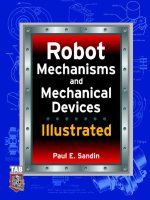McGraw-Hill - Robot Mechanisms and Mechanical Devices Illustrated - 2003 Part 6 ppsx
Bạn đang xem bản rút gọn của tài liệu. Xem và tải ngay bản đầy đủ của tài liệu tại đây (747 KB, 25 trang )
Chapter 2 Indirect Power Transfer Devices 89
Internal gears have teeth on the inside surface of a cylinder.
Spur gears are cylindrical gears with teeth that are straight and parallel to
the axis of rotation. They are used to transmit motion between parallel
shafts.
Rack gears have teeth on a flat rather than a curved surface that provide
straight-line rather than rotary motion.
Helical gears have a cylindrical shape, but their teeth are set at an angle
to the axis. They are capable of smoother and quieter action than spur
gears. When their axes are parallel, they are called parallel helical gears,
and when they are at right angles they are called helical gears.
Herringbone and worm gears are based on helical gear geometry.
Herringbone gears are double helical gears with both right-hand and
left-hand helix angles side by side across the face of the gear. This geom-
etry neutralizes axial thrust from helical teeth.
Worm gears are crossed-axis helical gears in which the helix angle of
one of the gears (the worm) has a high helix angle, resembling a screw.
Pinions are the smaller of two mating gears; the larger one is called the
gear or wheel.
Bevel gears have teeth on a conical surface that mate on axes that intersect,
typically at right angles. They are used in applications where there are
right angles between input and output shafts. This class of gears includes
the most common straight and spiral bevel as well as the miter and hypoid.
Straight bevel gears are the simplest bevel gears. Their straight teeth
produce instantaneous line contact when they mate. These gears pro-
vide moderate torque transmission, but they are not as smooth running
or quiet as spiral bevel gears because the straight teeth engage with
full-line contact. They permit medium load capacity.
Spiral bevel gears have curved oblique teeth. The spiral angle of cur-
vature with respect to the gear axis permits substantial tooth overlap.
Consequently, teeth engage gradually and at least two teeth are in con-
tact at the same time. These gears have lower tooth loading than
straight bevel gears, and they can turn up to eight times faster. They
permit high load capacity.
Miter gears are mating bevel gears with equal numbers of teeth and
with their axes at right angles.
Hypoid gears are spiral bevel gears with offset intersecting axes.
90 Chapter 2 Indirect Power Transfer Devices
Face gears have straight tooth surfaces, but their axes lie in planes per-
pendicular to shaft axes. They are designed to mate with instantaneous
point contact. These gears are used in right-angle drives, but they have
low load capacities.
Designing a properly sized gearbox is not a simple task and tables or
manufacturer’s recommendations are usually the best place to look for
help. The amount of power a gearbox can transmit is affected by gear
size, tooth size, rpm of the faster shaft, lubrication method, available
cooling method (everything from nothing at all to forced air), gear mate-
rials, bearing types, etc. All these variables must be taken into account to
come up with an effectively sized gearbox. Don’t be daunted by this. In
most cases the gearbox is not designed at all, but easily selected from a
large assortment of off-the-shelf gearboxes made by one of many manu-
facturers. Let’s now turn our attention to more complicated gearboxes
that do more than just exchange speed for torque.
Worm Gears
Worm gear drives get their name from the unusual input gear which
looks vaguely like a worm wrapped around a shaft. They are used prima-
rily for high reduction ratios, from 5:1 to 100s:1. Their main disadvan-
tage is inefficiency caused by the worm gear’s sliding contact with the
worm wheel. In larger reduction ratios, they can be self locking, meaning
when the input power is turned off, the output cannot be rotated. The fol-
lowing section discusses an unusual double enveloping, internally-lubri-
cated worm gear layout that is an attempt to increase efficiency and the
life of the gearbox.
WORM GEAR WITH HYDROSTATIC
ENGAGEMENT
Friction would be reduced greatly.
Lewis Research Center, Cleveland, Ohio
In a proposed worm-gear transmission, oil would be pumped at high
pressure through the meshes between the teeth of the gear and the worm
coil (Figure 2-16). The pressure in the oil would separate the meshing
surfaces slightly, and the oil would reduce the friction between these sur-
Chapter 2 Indirect Power Transfer Devices 91
faces. Each of the separating forces in the several meshes would con-
tribute to the torque on the gear and to an axial force on the worm. To
counteract this axial force and to reduce the friction that it would other-
wise cause, oil would also be pumped under pressure into a counterforce
hydrostatic bearing at one end of the worm shaft.
This type of worm-gear transmission was conceived for use in the
drive train between the gas-turbine engine and the rotor of a helicopter
and might be useful in other applications in which weight is critical.
Worm gear is attractive for such weight-critical applications because (1)
it can transmit torque from a horizontal engine (or other input) shaft to a
vertical rotor (or other perpendicular output) shaft, reducing the speed by
the desired ratio in one stage, and (2) in principle, a one-stage design can
be implemented in a gearbox that weighs less than does a conventional
helicopter gearbox.
Heretofore, the high sliding friction between the worm coils and the
gear teeth of worm-gear transmissions has reduced efficiency so much
Figure 2-16 Oil would be
injected at high pressure to
reduce friction in critical areas of
contact
92 Chapter 2 Indirect Power Transfer Devices
that such transmissions could not be used in helicopters. The efficiency
of the proposed worm-gear transmission with hydrostatic engagement
would depend partly on the remaining friction in the hydrostatic meshes
and on the power required to pump the oil. Preliminary calculations
show that the efficiency of the proposed transmission could be the same
as that of a conventional helicopter gear train.
Figure 2-17 shows an apparatus that is being used to gather experi-
mental data pertaining to the efficiency of a worm gear with hydrostatic
engagement. Two stationary disk sectors with oil pockets represent the
gear teeth and are installed in a caliper frame. A disk that represents the
worm coil is placed between the disk sectors in the caliper and is rotated
rapidly by a motor and gearbox. Oil is pumped at high pressure through
the clearances between the rotating disk and the stationary disk sectors.
The apparatus is instrumented to measure the frictional force of meshing
and the load force.
The stationary disk sectors can be installed with various clearances
and at various angles to the rotating disk. The stationary disk sectors can
be made in various shapes and with oil pockets at various positions. A
flowmeter and pressure gauge will measure the pump power. Oils of var-
ious viscosities can be used. The results of the tests are expected to show
the experimental dependences of the efficiency of transmission on these
factors.
It has been estimated that future research and development will make
it possible to make worm-gear helicopter transmission that weigh half as
much as conventional helicopter transmissions do. In addition, the new
hydrostatic meshes would offer longer service life and less noise. It
Figure 2-17 This test apparatus
simulates and measures some of
the loading conditions of the pro-
posed worm gear with hydro-
static engagement. The test data
will be used to design efficient
worm-gear transmissions.
Chapter 2 Indirect Power Transfer Devices 93
might even be possible to make the meshing worms and gears, or at least
parts of them, out of such lightweight materials as titanium, aluminum,
and composites.
This work was done by Lev. I. Chalko of the U.S. Army Propulsion
Directorate (AVSCOM) for Lewis Research Center.
CONTROLLED DIFFERENTIAL DRIVES
By coupling a differential gear assembly to a variable speed drive, a
drive’s horsepower capacity can be increased at the expense of its speed
range. Alternatively, the speed range can be increased at the expense of
the horsepower range. Many combinations of these variables are possi-
ble. The features of the differential depend on the manufacturer. Some
systems have bevel gears, others have planetary gears. Both single and
double differentials are employed. Variable-speed drives with differential
gears are available with ratings up to 30 hp.
Horsepower-increasing differential. The differential is coupled so
that the output of the motor is fed into one side and the output of the
speed variator is fed into the other side. An additional gear pair is
employed as shown in Figure 2-18.
Output speed
Output torque
T
4
= 2T
3
= 2RT
2
Output hp
hp increase
Speed variation
nn
n
R
4
1
2
1
2
=+
hp =
+
Rn n
T
12
2
63 025,
⌬hp =
Rn
T
1
2
63 025,
nn
R
nn
44 22
1
2
max min max min
()−= −
94 Chapter 2 Indirect Power Transfer Devices
Figure 2-18
Figure 2-19
Chapter 2 Indirect Power Transfer Devices 95
Speed range increase differential (Figure 2-19). This arrangement
achieves a wide range of speed with the low limit at zero or in the reverse
direction.
TWIN-MOTOR PLANETARY GEARS PROVIDE
SAFETY PLUS DUAL-SPEED
Many operators and owners of hoists and cranes fear the possible cata-
strophic damage that can occur if the driving motor of a unit should fail
for any reason. One solution to this problem is to feed the power of two
motors of equal rating into a planetary gear drive.
Power supply. Each of the motors is selected to supply half the
required output power to the hoisting gear (see Figure 2-21). One motor
drives the ring gear, which has both external and internal teeth. The sec-
ond motor drives the sun gear directly.
Both the ring gear and sun gear rotate in the same direction. If both
gears rotate at the same speed, the planetary cage, which is coupled to
Figure 2-20 A variable-speed
transmission consists of two sets
of worm gears feeding a differen-
tial mechanism. The output shaft
speed depends on the difference
in rpm between the two input
worms. When the worm speeds
are equal, output is zero. Each
worm shaft carries a cone-shaped
pulley. These pulley are mounted
so that their tapers are in oppo-
site directions. Shifting the posi-
tion of the drive belt on these
pulleys has a compound effect on
their output speed.
96 Chapter 2 Indirect Power Transfer Devices
the output, will also revolve at the same speed (and in the same direc-
tion). It is as if the entire inner works of the planetary were fused
together. There would be no relative motion. Then, if one motor fails, the
cage will revolve at half its original speed, and the other motor can still
lift with undiminished capacity. The same principle holds true when the
ring gear rotates more slowly than the sun gear.
No need to shift gears. Another advantage is that two working speeds
are available as a result of a simple switching arrangement. This makes is
unnecessary to shift gears to obtain either speed.
The diagram shows an installation for a steel mill crane.
HARMONIC-DRIVE SPEED REDUCERS
The harmonic-drive speed reducer was invented in the 1950s at the
Harmonic Drive Division of the United Shoe Machinery Corporation,
Beverly, Massachusetts. These drives have been specified in many high-
performance motion-control applications. Although the Harmonic Drive
Division no longer exists, the manufacturing rights to the drive have been
sold to several Japanese manufacturers, so they are still made and sold.
Most recently, the drives have been installed in industrial robots, semi-
conductor manufacturing equipment, and motion controllers in military
and aerospace equipment.
The history of speed-reducing drives dates back more than 2000
years. The first record of reducing gears appeared in the writings of the
Roman engineer Vitruvius in the first century
B.C. He described wooden-
Figure 2-21 Power flow from
two motors combine in a plane-
tary that drives the cable drum.
Chapter 2 Indirect Power Transfer Devices 97
tooth gears that coupled the power of water wheel to millstones for
grinding corn. Those gears offered about a 5 to 1 reduction. In about 300
B.C., Aristotle, the Greek philosopher and mathematician, wrote about
toothed gears made from bronze.
In 1556, the Saxon physician, Agricola, described geared, horse-
drawn windlasses for hauling heavy loads out of mines in Bohemia.
Heavy-duty cast-iron gear wheels were first introduced in the mid-
eighteenth century, but before that time gears made from brass and other
metals were included in small machines, clocks, and military equipment.
The harmonic drive is based on a principle called strain-wave gear-
ing, a name derived from the operation of its primary torque-transmitting
element, the flexspline. Figure 2-22 shows the three basic elements of
the harmonic drive: the rigid circular spline, the fliexible flexspline, and
the ellipse-shaped wave generator.
The circular spline is a nonrotating, thick-walled, solid ring with
internal teeth. By contrast, a flexspline is a thin-walled, flexible metal
cup with external teeth. Smaller in external diameter than the inside
diameter of the circular spline, the flexspline must be deformed by the
wave generator if its external teeth are to engage the internal teeth of the
circular spline.
When the elliptical cam wave generator is inserted into the bore of the
flexspline, it is formed into an elliptical shape. Because the major axis of
the wave generator is nearly equal to the inside diameter of the circular
Figure 2-22 Exploded view of a
typical harmonic drive showing
its principal parts. The flexspline
has a smaller outside diameter
than the inside diameter of the
circular spline, so the elliptical
wave generator distorts the flexs-
pline so that its teeth, 180º apart,
mesh.
98 Chapter 2 Indirect Power Transfer Devices
spline, external teeth of the flexspline that are 180° apart will
engage the internal circular-spline teeth.
Modern wave generators are enclosed in a ball-bearing
assembly that functions as the rotating input element. When
the wave generator transfers its elliptical shape to the flexs-
pline and the external circular spline teeth have engaged the
internal circular spline teeth at two opposing locations, a pos-
itive gear mesh occurs at those engagement points. The shaft
attached to the flexspline is the rotating output element.
Figure 2-23 is a schematic presentation of harmonic gear-
ing in a section view. The flexspline typically has two fewer
external teeth than the number of internal teeth on the circular
spline. The keyway of the input shaft is at its zero-degree or
12 o’clock position. The small circles around the shaft are the
ball bearings of the wave generator.
Figure 2-24 is a schematic view of a harmonic drive in
three operating positions. In Figure 2-24A, the inside and out-
side arrows are aligned. The inside arrow indicates that the
wave generator is in its 12 o’clock position with respect to the
circular spline, prior to its clockwise rotation.
Figure 2-23 Schematic of a typical harmonic drive showing the mechani-
cal relationship between the two splines and the wave generator.
Figure 2-24 Three positions of the wave generator: (A) the 12 o’clock or
zero degree position; (B) the 3 o’clock or 90° position; and (C) the 360°
position showing a two-tooth displacement.
Chapter 2 Indirect Power Transfer Devices 99
Because of the elliptical shape of the wave generator, full tooth
engagement occurs only at the two areas directly in line with the major
axis of the ellipse (the vertical axis of the diagram). The teeth in line with
the minor axis are completely disengaged.
As the wave generator rotates 90° clockwise, as shown in Figure 2-24B,
the inside arrow is still pointing at the same flexspline tooth, which has
begun its counterclockwise rotation. Without full tooth disengagement at
the areas of the minor axis, this rotation would not be possible.
At the position shown in Figure 2-24C, the wave generator has made
one complete revolution and is back at its 12 o’clock position. The inside
arrow of the flexspline indicates a two-tooth per revolution displacement
counterclockwise. From this one revolution motion the reduction ratio
equation can be written as:
where:
GR =gear ratio
FS = number of teeth on the flexspline
CS = number of teeth on the circular spline
Example:
FS = 200 teeth
CS = 202 teeth
GR = = 100 : 1 reduction
As the wave generator rotates and flexes the thin-walled spline, the teeth
move in and out of engagement in a rotating wave motion. As might be
expected, any mechanical component that is flexed, such as the flexs-
pline, is subject to stress and strain.
Advantages and Disadvantages
The harmonic drive was accepted as a high-performance speed reducer
because of its ability to position moving elements precisely. Moreover,
there is no backlash in a harmonic drive reducer. Therefore, when posi-
tioning inertial loads, repeatability and resolution are excellent (one arc-
minute or less).
Because the harmonic drive has a concentric shaft arrangement, the
input and output shafts have the same centerline. This geometry con-
tributes to its compact form factor. The ability of the drive to provide
high reduction ratios in a single pass with high torque capacity recom-
mends it for many machine designs. The benefits of high mechanical
200
202 200−
GR
FS
CS FS
=
−
100 Chapter 2 Indirect Power Transfer Devices
efficiency are high torque capacity per pound and unit of volume, both
attractive performance features.
One disadvantage of the harmonic drive reducer has been its wind-up or
torsional spring rate. The design of the drive’s tooth form necessary for the
proper meshing of the flexspline and the circular spline permits only one
tooth to be completely engaged at each end of the major elliptical axis of
the generator. This design condition is met only when there is no torsional
load. However, as torsional load increases, the teeth bend slightly and the
flexspline also distorts slightly, permitting adjacent teeth to engage.
Paradoxically, what could be a disadvantage is turned into an advan-
tage because more teeth share the load. Consequently, with many more
teeth engaged, torque capacity is higher, and there is still no backlash.
However, this bending and flexing causes torsional wind-up, the major
contributor to positional error in harmonic-drive reducers.
At least one manufacturer claims to have overcome this problem with
redesigned gear teeth. In a new design, one company replaced the origi-
nal involute teeth on the flexspline and circular spline with noninvolute
teeth. The new design is said to reduce stress concentration, double the
fatigue limit, and increase the permissible torque rating.
The new tooth design is a composite of convex and concave arcs that
match the loci of engagement points. The new tooth width is less than the
width of the tooth space and, as a result of these dimensions and propor-
tions, the root fillet radius is larger.
FLEXIBLE FACE-GEARS MAKE EFFICIENT
HIGH-REDUCTION DRIVES
A system of flexible face-gearing provides designers with a means for
obtaining high-ratio speed reductions in compact trains with concentric
input and output shafts.
With this approach, reduction ratios range from 10:1 to 200:1 for sin-
gle-stage reducers, whereas ratios of millions to one are possible for
multi-stage trains. Patents on the flexible face-gear reducers were held
by Clarence Slaughter of Grand Rapids, Michigan.
Building blocks. Single-stage gear reducers consist of three basic
parts: a flexible face-gear (Figure 2-25) made of plastic or thin metal; a
solid, non-flexing face-gear; and a wave former with one or more sliders
and rollers to force the flexible gear into mesh with the solid gear at
points where the teeth are in phase.
The high-speed input to the system usually drives the wave former.
Low-speed output can be derived from either the flexible or the solid
face gear; the gear not connected to the output is fixed to the housing.
Chapter 2 Indirect Power Transfer Devices 101
Teeth make the difference. Motion between the two gears depends on a
slight difference in their number of teeth (usually one or two teeth). But
drives with gears that have up to a difference of 10 teeth have been devised.
On each revolution of the wave former, there is a relative motion
between the two gears that equals the difference in their numbers of
teeth. The reduction ratio equals the number of teeth in the output gear
divided by the difference in their numbers of teeth.
Two-stage (Figure 2-26) and four-stage (Figure 2-27) gear reducers
are made by combining flexible and solid gears with multiple rows of
teeth and driving the flexible gears with a common wave former.
Hermetic sealing is accomplished by making the flexible gear serve as
a full seal and by taking output rotation from the solid gear.
Figure 2-25 A flexible face-gear
is flexed by a rotating wave for-
mer into contact with a solid gear
at point of mesh. The two gears
have slightly different numbers of
teeth.
Figure 2-26 A two-stage speed reducer is driven by a com-
mon-wave former operating against an integral flexible gear
for both stages.
Figure 2-27 A four-stage speed reducer can, theoretically,
attain reductions of millions to one. The train is both com-
pact and simple.
102 Chapter 2 Indirect Power Transfer Devices
HIGH-SPEED GEARHEADS IMPROVE SMALL
SERVO PERFORMANCE
The factory-made precision gearheads now available for installation in
the latest smaller-sized servosystems can improve their performance
while eliminating the external gears, belts, and pulleys commonly used
in earlier larger servosystems. The gearheads can be coupled to the
smaller, higher-speed servomotors, resulting in simpler systems with
lower power consumption and operating costs.
Gearheads, now being made in both in-line and right-angle configu-
rations, can be mounted directly to the drive motor shafts. They can
convert high-speed, low-torque rotary motion to a low-speed, high-
torque output. The latest models are smaller and more accurate than
their predecessors, and they have been designed to be compatible with
the smaller, more precise servomotors being offered today.
Gearheads have often been selected for driving long trains of mecha-
nisms in machines that perform such tasks as feeding wire, wood, or
metal for further processing. However, the use of an in-line gearhead
adds to the space occupied by these machines, and this can be a problem
where factory floor space is restricted. One way to avoid this problem is
to choose a right-angle gearhead (Figure 2-28). It can be mounted verti-
cally beneath the host machine or even horizontally on the machine bed.
Horizontal mounting can save space because the gearheads and motors
can be positioned behind the machine, away from the operator.
Bevel gears are commonly used in right-angle drives because they can
provide precise motion. Conically shaped bevel gears with straight- or
spiral-cut teeth allow mating shafts to intersect at 90º angles. Straight-cut
bevel gears typically have contact ratios of about 1.4, but the simultane-
ous mating of straight teeth along their entire lengths causes more vibra-
tion and noise than the mating of spiral-bevel gear teeth. By contrast, spi-
ral-bevel gear teeth engage and disengage gradually and precisely with
contact ratios of 2.0 to 3.0, making little noise. The higher contact ratios
of spiral-bevel gears permit them to drive loads that are 20 to 30% greater
than those possible with straight bevel gears. Moreover, the spiral-bevel
teeth mesh with a rolling action that increases their precision and also
reduces friction. As a result, operating efficiencies can exceed 90%.
Simplify the Mounting
The smaller servomotors now available force gearheads to operate at
higher speeds, making vibrations more likely. Inadvertent misalignment
between servomotors and gearboxes, which often occurs during installa-
tion, is a common source of vibration. The mounting of conventional
Chapter 2 Indirect Power Transfer Devices 103
motors with gearboxes requires several precise connections. The output
shaft of the motor must be attached to the pinion gear that slips into a set
of planetary gears in the end of the gearbox, and an adapter plate must
joint the motor to the gearbox. Unfortunately, each of these connections
can introduce slight alignment errors that accumulate to cause overall
motor/gearbox misalignment.
Figure 2-28 This right-angle gearhead is designed for high-performance servo applica-
tions. It includes helical planetary output gears, a rigid sun gear, spiral bevel gears, and a
balanced input pinion. Courtesy of Bayside Controls Inc.
104 Chapter 2 Indirect Power Transfer Devices
The pinion is the key to smooth operation because it must be aligned
exactly with the motor shaft and gearbox. Until recently it has been standard
practice to mount pinions in the field when the motors were connected to the
gearboxes. This procedure often caused the assembly to vibrate. Engineers
realized that the integration of gearheads into the servomotor package
would solve this problem, but the drawback to the integrated unit is that fail-
ure of either component would require replacement of the whole unit.
A more practical solution is to make the pinion part of the gearhead
assembly because gearheads with built-in pinions are easier to mount to
servomotors than gearheads with field-installed pinions. It is only neces-
sary to insert the motor shaft into the collar that extends from the gear-
head’s rear housing, tighten the clamp with a wrench, and bolt the motor
to the gearhead.
Pinions installed at the factory ensure smooth-running gearheads
because they are balanced before they are mounted. This procedure per-
mits them to spin at high speed without wobbling. As a result, the bal-
anced pinions minimize friction and thus cause less wear, noise, and
vibration than field-installed pinions.
However, the factory-installed pinion requires a floating bearing to
support the shaft with a pinion on one end. The Bayside Motion Group
of Bayside Controls Inc., Port Washington, New York, developed a self-
aligning bearing for this purpose. Bayside gearheads with these pinions
are rated for input speeds up to 5000 rpm. A collar on the pinion shaft’s
other end mounts to the motor shaft. The bearing holds the pinion in
place until it is mounted. At that time a pair of bearings in the servomo-
tor support the coupled shaft. The self-aligning feature of the floating
bearing lets the motor bearing support the shaft after installation.
The pinion and floating bearing help to seal the unit during its opera-
tion. The pinion rests in a blind hole and seals the rear of the gearhead.
This seal keeps out dirt while retaining the lubricants within the housing.
Consequently, light grease and semifluid lubricants can replace heavy
grease.
Cost-Effective Addition
The installation of gearheads can smooth the operation of servosystems as
well as reduce system costs. The addition of a gearhead to the system does
not necessarily add to overall operating costs because its purchase price
can be offset by reductions in operating costs. Smaller servomotors inher-
ently draw less current than larger ones, thus reducing operating costs, but
those power savings are greatest in applications calling for low speed and
high torque because direct-drive servomotors must be considerably larger
than servomotors coupled to gearheads to perform the same work.
Chapter 2 Indirect Power Transfer Devices 105
Small direct-drive servomotors assigned to high-speed/low-torque
applications might be able to perform the work satisfactorily without a
gearhead. In those instances servo/gearhead combinations might not be
as cost-effective because power consumption will be comparable.
Nevertheless, gearheads will still improve efficiency and, over time, even
small decreases in power consumption due to the use of smaller-sized
servos will result in reduced operating costs.
The decision to purchase a precision gearhead should be evaluated on
a case-by-case basis. The first step is to determine speed and torque
requirements. Then keep in mind that although in high-speed/low-torque
applications a direct-drive system might be satisfactory, low-speed/high-
torque applications almost always require gearheads. Then a decision
can be made after weighing the purchase price of the gearhead against
anticipated servosystem operating expenses in either operating mode to
estimate savings.
The planetary gearbox is one of the most efficient and compact gear-
box designs. Its internal coaxial layout reduces efficiency robbing side
loads on the gear’s shafts. Figure 2-29 and the following tables give the
formulas required to calculate the input/output ratios. In spite of its
higher cost, a planetary gearbox is frequently the best choice for medium
ratio power transfer. Because of its even greater precision requirement
than spur gears, it is usually better to buy an off-the-shelf gearbox than to
design your own.
Figure 2-29 Simple Planetaries and Inversions
This page intentionally left blank.
Chapter 3 Direct Power
Transfer Devices
Copyright © 2003 by The McGraw-Hill Companies, Inc. Click here for Terms of Use.
This page intentionally left blank.
COUPLINGS
At some point in a mobile robot designer’s career there will be a need to
couple two shafts together. Fortunately, there are many commercially
available couplers to pick from, each with its own strengths and weak-
nesses. Couplers are available in two major styles: solid and flexible.
Solid couplers must be strong enough to hold the shafts’ ends together as
if they were one shaft. Flexible couplers allow for misalignment and are
used where the two shafts are already running in their own bearings, but
might be slightly out of alignment. The only other complication is that
the shafts may be different diameters, or have different end details like
splined, keyed, hex, square, or smooth. The coupler simply has different
ends to accept the shafts it is coupling.
Solid couplers are very simple devices. They clamp onto each shaft
tight enough to transmit the torque from one shaft onto the other. The
shafts styles in each end of the coupler can be the same or different. For
shaped shafts, the coupler need only have the same shape and size as the
shaft and bolts or other clamping system to hold the coupler to the shaft.
For smooth shafts, the coupler must clamp to the shaft tight enough to
transmit the torque through friction with the shaft surface. This requires
very high clamping forces, but is a common method because it requires
no machining of the shafts.
As for online sources of couplers, and more detailed information
about torque carrying ability, check out these web sites:
• powertransmission.com
• dodge-pt.com
• flexibleshaftcouplings.com
• wmberg.com
• mcmastercarr.com
109
110 Chapter 3 Direct Power Transfer Devices
METHODS FOR COUPLING
ROTATING SHAFTS
Methods for coupling rotating shafts vary from simple bolted flange assem-
bles to complex spring and synthetic rubber assembles. Those including
chain belts, splines, bands, and rollers are shown here.
Figure 3-1
Figure 3-2
Figure 3-3
Figure 3-4
Chapter 3 Direct Power Transfer Devices 111
Figure 3-5
Figure 3-6
Figure 3-7 Figure 3-8
112 Chapter 3 Direct Power Transfer Devices
Figure 3-9
Figure 3-10
Figure 3-11
Figure 3-12 Figure 3-13
Chapter 3 Direct Power Transfer Devices 113
Shaft couplings that include internal and external gears, balls, pins, and
nonmetallic parts to transmit torque are shown here.
Figure 3-14
Figure 3-16
Figure 3-18
Figure 3-15
Figure 3-17
Figure 3-17
